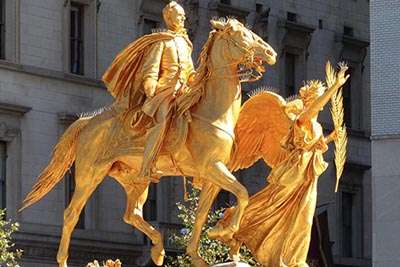It’s Monday, December 29, 2025 in Austin, Texas
Bob Atchison's Guide to Bronze Patinas
Most people do not realize that bronze statues have artificial patinas applied to their surfaces. This blog article discusses the types of bronze patinas and how to recognize them. Bronze gilding is discussed at length and there is an introduction to the bronzes of Constantinople.
I have just published a "My Favorite Semi-Precious Stones for Hardstone Animals" - click here if you want to read it.
The Two Types of Bronze Patinas
 Most people do not realize that bronze statues have artificial patinas applied to their surfaces. Now we are not talking about ancient statues that have been dug up from the ground or raised from the seabed. Those bronzes have natural patinas that have taken hundreds of years to develop. Some ancient statues, like the bronzes from the Villa of the Papyri in Herculaneum have been restored and in the process have had new patinas applied. Only a few ancient statues — like the equestrian statue of Marcus Aurelius from Rome have survived without ever being buried or immersed in the sea and thus still possess their original surface. The only reason the statue of Marcus Aurelius was saved from the melting pot was that in medieval times that thought he was the Christian Emperor Constantine.
Most people do not realize that bronze statues have artificial patinas applied to their surfaces. Now we are not talking about ancient statues that have been dug up from the ground or raised from the seabed. Those bronzes have natural patinas that have taken hundreds of years to develop. Some ancient statues, like the bronzes from the Villa of the Papyri in Herculaneum have been restored and in the process have had new patinas applied. Only a few ancient statues — like the equestrian statue of Marcus Aurelius from Rome have survived without ever being buried or immersed in the sea and thus still possess their original surface. The only reason the statue of Marcus Aurelius was saved from the melting pot was that in medieval times that thought he was the Christian Emperor Constantine.
Later on I will talk about the horses of St. Mark's in Venice. These bronzes are in a remarkable state of preservation and have been on view ever since their creation. Another ancient bronze that has been known since ancient times is the famous "Thorn Picker" - "the Spinario" from Rome. You can see it above on the right. It still has it's original patina, the surface is natural, the result of people touching it over the years.
There are two types of patinas, those applied though firing on or chemical reactions in the foundry and artistic patinas that are applied with colors, varnishes and waxes. Most people who visit this page are trying to identify a patina on a bronze they have bought - or are thinking of buying or people who have bronzes with damaged surfaces that they want to repair. Very few people today are ordering or commissioning bronzes directly from the foundry. Those who are need to carefully consider the patinas that are available to them because once a foundry patina has been applied it is irreversible. Sometimes it is possible to apply a second patina over the first, but you can't be sure of the results because there is a chemical reaction in the patina when it is applied. Mix the chemicals up, add fire and you might totally ruin a bronze. I made a bad mistake in the patina I had ordered from a Chinese foundry on a dozen bronzes. There have been no problems with the second 'coat' ten years later and the bronzes are all outside in the elements.
Chinese Bronzes on Ebay
Virtually all of the small bronzes sold on Ebay are from China. They are really cheap; you can buy a decent sized desktop bronze for around $100.00. Twelve years ago the Chinese flooded the market with these and wiped out all of the European producers within a year or two. Those guys were mostly based in Spain and Portugal. If you pay $100 for a Chinese bronze the net cost at the foundry is $10 or less. They mass produce the waxes and their low labor costs mean the cost of casting and finishing is as low as it could possibly get. The biggest cost is the metal and the ingredients for bronze can be expensive in China and hard to get. I suspect the Chinese foundries mix in other metals to extend the "bronze" available. In the beginning the Chinese offered catalogs of hundreds of different bronzes. They all looked the same because they used the same molds - or bought their casting waxes from the same sources. If you tried to order a lot of things it turned out almost nothing was in stock and everything had to be produced to ship. Most of the Chinese bronzes that were reproductions of famous statues, vases, clocks and lamps. Their molds weren't taken from original items they were obviously modeled from pictures. If an item is not reproduced from a mold taken from an original it will not be the same. In many cases the Chinese made the terrible mistake of attempting to "improve" or modernize the originals. You can see this in "reproductions" of ancient Greek or Roman bronzes with big breasts or improved facial features to make them more attractive to the guy in China who was making the model. This resulted in the mass of silly bronzes you can buy online. The Chinese are making fewer and fewer options for wholesalers to pick from. Almost all of the Chinese bronzes have one type of a patina - their version of Renaissance brown.
It might seem like brown would be an easy patina to make and sell, but brown can be reddish, it can be greenish, it can be yellowish. The brown patina applied to Europe is unique, the companies who made these in Spain and Portugal had made them for generations and the traditions color and style was passed down generation after generation. Before the Spanish and the Portuguese starting making their mass-produced bronzes they had been made in France and Italy, whose foundries went out of business.
The leopard shown below has a wonderful brown patina. This bronze was created by the famous UK artist, Jonathan Knight, who specializes in animal sculptures. This patina has been artistically applied.
Different Sources of Bronzes
Over the years I have worked with the Russians, Poles, Romanians and the Chinese. My experiences with each of them has been different.
The Russians are exceptional at matching the Neoclassical style and do fantastic chasing. They still do mercury gilding. I think they are the only ones will will. The Russians find it hard commit to production schedules and you never can be sure if the items you buy will make it to you. The Russian craftsmen are amazing, they have usually been taught by masters who come from a line of artists that go back to before the revolution. Russian customs has elaborate rules and restrictions on exports. The Poles always work from original molds, do great chasing and everything is electroplated. They can build or ship as much as you want and they never miss a deadline in then production timeline. There are no problems with wire transfers or payments. The Romanians are very hard workers, they are best creating original works of art rather that making reproductions. Romanians are spirited and enthusiastic business partners. I haven't had any problems with them. The Chinese will give you the best deal and and commit to aggressive production timelines. They have problems in getting the models right and they don't have natural understanding of Western aesthetic. It is almost impossible for them to reproduce a neoclassical bronze. I once found a miraculous guy who could make classical statue models, I used him over and over again and then he went away. I always had to work through Chinese middlemen, which was OK because they would get things done on time and handle shipping, but I never could have a relationship with the craftspeople themselves like I could in Europe.
Finding Antique Bronzes Online
f you are looking for incredible examples of classical bronzes you can often they go for virtually nothing on Live Auctioneers. Recently there was a life-sized cast of the famous Doryphoros from a 19th century Italian foundry that sold for $4,000. It was cast from an original mold and was identical to the original. Wow, that's nothing. The main thing to consider about buying at auction is the add-on fee the auctioneer charges and shipping costs.
I found a life-sized, 18th century cast of a bust of Sappho from the Villa of the Papyri for $700 on Ebay. It had the original marks of the Royal Bourbon foundry of Naples. There are still many finds out there of antique bronzes. You just have to look and know what to look for. There are plenty of books out there that can help you identify bronzes. Ancient Greek and Roman sculpture - the genuine items - sell for almost nothing at auction. They are practically giving them away. It's because ancient art - especially classical art - is out of favor these days with investors. Things that sold for millions 10 years ago now can be had for a tenth of that. One of the things that made it hard to find any bidder on my Sappho was it looks a little scary because it has white, inlaid eyes. Ancient bronzes usually had eyes inlaid with shell, grass and colored store. The originals where not patinated in Herculaneum Black they were shown in bright bronze - like a gilt statue. The ad on Ebay didn't know it was Sappho, didn't know what the foundry mark was (three dots in the shape of a triangle) and had no idea how old it was. Actually my Sappho is very beautiful, especially in profile. Here she is below:
But now I must return to my list of patinas. I want to illustrate the various patinas and give you my recommendation on which finishes work best for your statue and its use. Here are some examples:
 NATURAL BRONZE
NATURAL BRONZE
Here is the natural color of bronze when it comes out of the mold. It looks like brass or gold and the finish is very bright and shiny. The ancient Greeks and Romans actually preferred this which we find garish today. It is difficult to maintain — without waxing as a protective layer the surface of the bronze will inevitably oxidize and change. The process can be uneven, ugly and unattractive, with dark brown and green streaks developing. Over time the surface will even out, but this can take a very long time.
I remember many years ago the statue of Chief Seattle in Downtown Seattle was stripped of its green patina and it was decided to go 'natural' and let the real bronze color age. It was a horrible decision and the statue looked hideous in a year. So, the natural finish is never recommended. If you want this look it is better to go with gilding. Below I explain how you can use varnishes over natural bronze for a gilded effect. Many of the "natural' bronzes you see today have this finish. You can apply various gilder's waxes to the surface of the bronze later. I love gilder's waxes but you have to be very careful cleaning a bronze where you have used them because they can easily dissolve in anything with an alcohol base to it.
 RENAISSANCE BROWN
RENAISSANCE BROWN
This is an applied brown patina. It is called Renaissance Brown because it was very popular in Italy in the 15th, 16th and 17th centuries. The greatest bronze casters of the time used this patina, so you can't go wrong choosing it.
During this period the art of large scale bronze casting was revived and craftsmen had to relearn all of the techniques that had been lost since Roman times. The sculpture is of the Wrestlers by the Greek sculptor, Myron. The best copy is in the Uffizi Gallery in Florence. The original was lost.
The bronze finish works very well for small scale bronzes or statues that will be kept inside. You can use gilder's waxes, which come in many colors to help add the illusion of age. Don't forget what I wrote earlier about cleaning bronzes you have applied gilder's waxes to. I use multiple colors on the same piece. On brown you could use red, dark brown and black. You can even apply gold highlights and make it look like a bronze is old and has been handled buy human hands. Black can add depth and age, too. Once you have tried this you can learn very subtle ways of using them. One of the great things about gilder's waxes is they are easy to use and don't damage your original patina. You can't varnish them, they will dissolve. You can't use sculpture was on top of them because new was will also dissolve the old one.
Some marvelous effects can be achieved with this patina when it is applied artistically and subtly. It can enhance fine casting and engraving of bronzes. You can't go wrong with this finish and it is a safe choice if you don't have experience with patinas.
Don't forget that you will need good lighting for any bronzes that are displayed indoors.
 HERCULANEUM BLACK
HERCULANEUM BLACK
The Merman on the right is a copy I had made in China of a statue in a fountain in the Piazza Nova in Rome.
This patina is named for the surface color that has been used in the statues unearthed from the ancient town that was buried by Vesuvius in 79AD. In the 18th century the Bourbon rules of Naples unearthed a huge hoard of bronzes from the Villa of the Papyri (mentioned above). When these bronzes were brought to the surface almost all of them required extensive restoration. During the eruption most of the bronzes were thrown from their bases and crushed by flying stones, tiles and other things blown about by the powerful pyroclastic flow. After the statues were repaired the Bourbon restorers applied a green black patina to the bronze surface to level everything out and conceal any imperfections in the surface finish. At the time the discoveries at Herculaneum created a revolution in the decorative arts of the time. Every aristocratic home had to have a collection of bronzes from Pompeii and Herculaneum.
There were foundries in Italy that mass produced extremely high quality reproductions made from molds taken directly from the originals — all made with a Herculaneum Black patina. This popularized the color, which the Romans probably never used. It works very well for outdoor sculptures, where it will age and develop beautiful natural green areas. It does not work well inside unless you have very bright natural or artificial light. The overall color is usually applied flat without any artistic modifications. This patina can last on a bronze for decades in the hot sun and the elements without changing. It is really stable. The formula for Herculaneum black can be very different around the world. The Europeans use the tried and true formula that has been around for 500 years. The Chinese have come up with their own formula just to mimic the color. I know it might sound strange unless you have seen it, is that Chinese black is a unique color. I have Italian bronzes and Chinese bronzes in this patina sitting right next to each other and you can see the difference. I think the Chinese hue is a richer black. Maybe it has something to do with Chinese black lacquer setting a historical standard for them in defining the best, richest black.
 POMPEII GREEN
POMPEII GREEN
This is the color that is found on many ancient statues that have been buried in the earth or found on the sea bed. Many modern statues — especially outdoor ones — are given this patina to age them. I like this finish because I like green things in general. Pompeii Green can have the appearance of light spotted serpentine or nephrite. It can have multiple colors in it, emerald, teal, sea-green and reddish brown.
It shows details very well and was popular in England and France in the 19th century. In the 18th and 19th centuries bronze statues that were found in the sea or dug out of the ground would have lots of accretions attached to the surface. If the statue came the sea this would be shells and remains of other sea creatures combined with corrosion. A statue in this state could hardly be recognized as a human figure. As found buyers in 18th century Europe would have little interest in a bronze in this state. Italian restorers would grind and remove the secretions with chisels, working their way down until they found the original sculpture. This was very hard work. Then they would polish the surface of the bronze to achieve a result like the huge lion's head above. I think this lion came from Caligula's floating boat-palace on Lake Nemi. It is not a door knocker, it was probably used to lash the Imperial yacht to a pier.
It is very difficult to apply this patina well and it often creates irreversible damage to the surface of the statue it is applied to. It can be quite corrosive. One applied you are stuck with the results.
Unless it is applied like you see at left — in a flat overall fashion — only a great patina craftsman can apply it effectively.
If it is applied in streaks and blotches to resemble 'age' on a statue it can look fake and distract from the beauty of a casting. So, I recommend only using this patina in a flat, overall manner.
 ARTISTIC PATINAS
ARTISTIC PATINAS
Here you can see a very subtle combination of colors on a bronze bust that is intended for internal display. This work would never be placed outdoors.
If you can find a foundry that does artistic patinas you can create amazing beautiful surfaces like this. Most foundries only want to apply one patina and don't have craftspeople who have the talent to apply patinas like this.
It's virtually a lost art.
Combinations of colors require a delicate touch and an understanding of the natural aging of bronze and the subtle play of surface finishes like the gilder's waxes I keep mentioning. Many artistic bronzes don't have real patinas on them, the surface is created by using many different colored varnishes and colors. You have probably heard of Austrian bronzes from the 19th and early 20th centuries that use these techniques to create their unique look. Over time Austrian bronze finishes can rub off and look terrible. People want to restore them and it's not that difficult, because you are using paints and varnishes, not a true patina.
There are many colors available for artistic patinas like blues and oranges, however unnatural colors are often garish and ugly. Because these are strong chemicals that are fired onto the surface of the bronze almost all of these cause Irreversible surface changes, so be careful before you experiment.
 GILT BRONZE
GILT BRONZE
In ancient Greek times statues were gilded by applying sheets of gold to a surface and locking them into channels engraved into the bronze surface. The Romans also work fine sheets of gold onto bronze statues using bone tools that burnished the gold onto the surface. Another technique involved the application of mercury and fired to forge the gold to bronze.
"The bronze surface would be coated with a mixture of ground gold—hence the name or moulu—and mercury, then heated over an open fire. While the gold adhered to the base metal, the mercury would evaporate, creating dangerous fumes. The process was repeated several times until a thick enough layer of gold had been created that could be left matte or was burnished with a heliotrope stone"
"Most objects, however, were not gilded, but simply cleaned by being dipped in acid and then lacquered with a clear or yellow varnish, which gave them the appearance of gold. Through use, the varnish rubbed off and the pieces would be revarnished. Other objects were subsequently gilded instead and, as a result, not many have survived that are varnished."
The technique of mercury gilding is very dangerous and is outlawed in the European Union. The second technique mentioned, the use of yellow or orange varnishes, was used a lot because it was cheaper, safer and anyone could do it. I have used it myself successfully. The use of yellow and orange varnishes has often been used over silver leaf to imitate gold. Many of the Byzantine icons at Sinai were done this way. The Russians also did it. You can use silver leaf on furniture to save money and apply these varnishes. It looks great. Bright gold leaf gilding can look very garish and using varnishes on gold can actually make a piece of furniture look more "real" to the modern eye. After varnishing you can also ad gilder's waxes to add even more of an aged patina.
Today most gilding is electroplating and involves a electric current placing a very thin layer of color on the surface of the metal. There are many techniques to make the surface bright or matte. These are important to duplicate and essential for the recreation of decorative Empire period bronzes.
The William Tecumseh Sherman Monument - a Lesson in the Dangers of a Bad Gilding Job
The William Tecumseh Sherman Monument is an outdoor sculpture by Augustus Saint-Gaudens, located at Grand Army Plaza in Manhattan, New York. It was cast in 1902 and dedicated on May 30, 1903, the gilded-bronze monument consists of an equestrian statue and an allegorical female figure of Victory and is set on a Stony Creek granite pedestal designed by the architect Charles Follen McKim. The statue of General Sherman lead by Victory has been re-gilded twice in the last 30 years. It is impossible to take the statue to a foundry for a proper gilding, so it has done in place. Since mercury gilding could never been done on this statue group while it stands in the middle of New York City, it was decided to use oil gilding using adhesives. I assume they must have applied several layers of gold leaf. At first the statues looked amazing, but soon the gilding began to peal and flake. It looked horrible. They had to re-gild again trying a different adhesive. This is from a news article in 2013 about it:
"Tourists visiting the famous General Sherman statue at Grand Army Plaza, near the Plaza Hotel, were shocked at the condition of the masterpiece by revered sculptor Augustus Saint-Gaudens.
“It’s not looking very good, with all the peeling and black, when it should be gorgeous,” Maryl Hitchings told CBS 2’s Tony Aiello.
“Looks sort of decrepit, said Bill Hitchings.
The gold leaf is peeling, leaving huge splotches of dark bronze showing through from underneath.
“It’s a magnificent statue, has a lot to say and I think someone needs to restore it,” said tourist Barbra Hurley.
In fact, it was restored in 1990. The gold leaf cost more than $115,000.
At the time of the 1990 restoration, a very rich, very prominent New Yorker wrote to the New York Times with what looked like a promise.
Richard J. Schwartz criticized the gold leaf as “garish and vulgar,” but also wrote “The foundation I head has agreed to provide the funds to maintain the monument in perpetuity.”
 Above you can see the condition of the statue in 2013 - the black patches are really bad. That's the adhesive they used showing through. In 2013 $500,000 was spent to restore the statue. The New York Times wrote an excellent article about how they restored the gilding. You can read it by clicking here. You will read that they used paint to try and dull the gold.
Above you can see the condition of the statue in 2013 - the black patches are really bad. That's the adhesive they used showing through. In 2013 $500,000 was spent to restore the statue. The New York Times wrote an excellent article about how they restored the gilding. You can read it by clicking here. You will read that they used paint to try and dull the gold.
Gilded statues can practically blind you when they flash sunlight. Toning down or dulling the gold has been done since ancient times. After the horses of Saint Marks were gilded the ancient foundry scratched the surface on the most reflective parts. When you see the horses up close the scratches are easy to see - disturbing; it looks like they were intently damaged by vandals.
The Four Bronze Horses of St. Mark's and Their Gilding
In Constantinople the horses were placed on top of the curved entrance to the Hippodrome, which was called the "Dippion", high above the ground. From this distance and being below the crowds in the Hippodrome would not have been able to see this. When the horses were looted from Constantinople during the Fourth Crusade in 1204 the horses were removed from the Hippodrome and sent to Venice as booty. In Venice they were placed in front of balcony on the front facade of Saint Mark's overlooking the square, with small marble columns (more loot) holding up the feet. If you stood on the balcony looking out on the square you could see the scratches on the behinds of horses. Due to the ravages of pollution, today the original horses have been placed in a special museum. Now you can examine them up close and see the abrasion for yourself.
The great statue of Marcus Aurelius in Rome also had it's mercury-gilded surfaces scratched up.
In this picture below you can plainly see the scratches on the most reflective surfaces of the horses.
We aren't sure how old the horses are - some experts believe they date from the reign of Constantine and were made-to-order for Constantinople herself. One of the features they point out to justify this dating is the shape of the eyes, which does not appear to be classical in style. Monumental bronze casting on a huge scale was still being done in the 4th Century AD reign of Constantine and there seems to have been no decline in the quality of the casting. Were they part of a quadriga? Since the hippodrome was built in the reign of Septimus Severus, were the horses a part of the original project?
Roman bronze casting was amazing and their techniques were not rivaled in the West until the 17th century. Roman bronzes were very thinly cast and assembled from many pieces fused together. The cost of bronze was very high and they wanted it to go as far as possible. By testing the metal content of Greek and Roman bronzes we can tell where they were made. Roman bronze is made of tin, copper and lead. There were some trace elements but the Romans were remarkably consistent in the formula for bronze casting for hundreds of years. One can assume that Greek and Roman bronze casting was perfected to produce stuff for the military and navy on an industrial scale. Even in the Byzantine period we know that hundreds of thousands of bronze arrows, spears, swords, armor and helmets could be produced fast and efficiently.
Constantine's Bronze Statue in His Forum in Constantinople
Constantine had a colossal nude gilded bronze statue of himself placed on a gigantic porphyry column at the center of his forum in Constantinople (the column can still be seen today - a complete ruin). He was crowned like the god Helios with sun rays. Constantine's Forum was filled with beautiful bronze statues from ancient Greece and Rome. The most famous was the Athena Promachos - "Athena who fights in the front line" by Phedias from the Athenian acropolis was here for 900 years (it was brought to the forum from Athens sometime after 465 AD, at the same time the gold and ivory statue of Athena from the acropolis was brought to Constantinople and placed in the palace of Lassos as a part of a public display of ancient sculpture) - until it was destroyed during the Fourth Crusade. It was destroyed by a mob of drunken crusaders. Constantine's statue stood for 800 years - and could be seen from sea as you sailed around the city - until it was knocked down by lightning in the 12th century. The Byzantine Emperor Manuel replaced the statue with a huge gilded cross. You can still see the 12th century marks and clamps on the top of the column where it was attached.
The Colossus of Barletta
Huge statues - including gigantic, gilded equestrian ones - were still being produced into the reign of Theodosis II and may have lasted until the 7th century into the reign of the Byzantine Emperor Heraclius. The huge Colossus of Barletta is probably a statue of the 5th century AD Byzantine Emperor Marcian and may have come from his column which still stands in Istanbul. There are marks on the top of the column where it was attached. Unfortunately, since the original lower legs are replaced we can't line up anything to prove it. The statue was most likely looted after 1204 as well. It washed ashore off the coast of Italy missing it's lower legs, arms and the crown of the head. It could have been damaged during it's removal from its column. Maybe it was sold for scrap and was being transported to Italy to be melted down. When it was first found it was dragged on land and left propped up as a curiosity. The arms and cross were replaced in the last 200 years, but must be very close to the original ones. Below you can see a picture of the Colossus with people - the huge scale is obvious.
 The Equestrian Statue of Justinian in the Augusteon
The Equestrian Statue of Justinian in the Augusteon
The largest and most prominent statue in Constantinople was a gigantic statue of the Emperor Theodosis. Later it was appropriated by the Emperor Justinian I and moved to an enormous brick column that was sheathed in marble outside his church of Hagia Sophia in the central colonnaded square of the city, the Augusteon. This column was almost as high as the dome of the church and could be seen at a great distance from the city. It was one of the chief attractions of the city that you would see as you rounded the tip of the city and entered the Golden Horn by sea. It was much commented on by travelers and was published in early maps and engravings. It even appears in manuscripts. It flashed in the sunlight and had been hit by lightning at least once. It faced east with his hand extended toward the enemies of Byzantium. His helmet was decorated with huge feathered plumes. The statue survived in place until the Ottoman conquest. Sultan Mehmet II ordered it destroyed. For a number of years fragments of it including the head - could be seen in a shed. Travelers saw the remains and remarked on their huge scale.

Our Return to the Sherman Monument in New York City
Ah, but I have digressed in my detour to Constantinople! Let us return to New York. Below is a picture of what the Sherman-Nike monument looks like today. The spikes on the top of the figure to discourage birds look like some strange alien fungus. I hate it. Hopefully that has mellowed in the last 5 years. I have a desktop copy of the Nike. She's 30 inches tall and very heavy! Once I fell off a ladder and knocked it over. The statue was not damaged but the wings put a hole in the wall that's still there.
Many bronze statues that look gilded are not. They are painted. A clever restorer can make high quality gold enamel paint look like gold-leaf. If you didn't know how it had been done you'd be satisfied with the results. It actually lasts a long time and can be polished up to a bright finish. This same gold paint is used by restorers on furniture. The use of paints masquerading as patinas is widespread. If a statue's patina surface has been damaged or scratched, paints may be needed for touch ups. If it's done right you can't see the difference. I have an 1820's copy of the Hermes in Repose from the Villa of the Papyri. There's a copy of it in the gardens of the Getty Villa in Malibu, California. It had a Pompeii Green patina that had applied in Naples when it was cast. Over the years since it was cast it had been rubbed and touched by hundreds of people. You could see the original bright gold color of the bronze on the tips of several of the fingers where the patina had rubbed off. It also looked like someone had spilled something acidic on the statue creating spots on the patina. I was able to mix paints that matched the surface patina perfectly and touched it up. Since it's an indoor sculpture I was able to use polymer paints. Had it been outdoors I could have used oil based enamels. It takes some skill to blend these colors and apply them, but in the case of polymer paints they are easy to remove if you don't like the results.
Helpful Hint - Clean Your Outdoor Statues Once a Year
Just as a reminder, every year you should clean your outdoor bronze statues. Rain water has a neutral PH and on it's own will not damage the patina-surface of your bronze. However many bronzes are under trees and rainwater washes dust from the leaves. Trees also drop sap. Bird poop is inevitably going to show up on your statues. If your statue is in a fountain or had water running over it you will get calcium build-up. Every year you should gently wash your statue with soapy water. You want to use big soft sponges - do not use brushes as they scratch the surface. If you have a build up of calcium on the surface you can also use a lime remover. Again use a huge very soft sponge to apply it. Gentle lime removal can do wonders for your statue. I leave it on for a couple of minutes, then do it again if it's necessary. After you have done this apply a new layer of wax - be sure to use a museum wax - don't use floor wax. Waxing every year is important. It protects the surface of your statue and gives it a nice, natural matte glow.
Bob Atchison





























 New Home Builder Website Checklist
New Home Builder Website Checklist 












